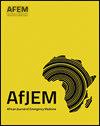A systematic review and meta-analysis of noradrenaline compared to adrenaline in the management of septic shock
IF 1.2
4区 医学
Q3 EMERGENCY MEDICINE
引用次数: 0
Abstract
Background: Septic shock is associated with significant mortality. The International Surviving Sepsis Campaign guidelines recommend noradrenaline as first-line vasopressor, whilst South African guidelines recommend adrenaline. Clinical trials show similar efficacy but suggest safety advantages for noradrenaline. We reviewed the evidence comparing noradrenaline and adrenaline in the initial management of adult patients with septic shock.
Methods: We searched PubMed, Epistemonikos, Cochrane Library, and clinical trial registries for clinical practice guidelines, health technology assessments, and systematic reviews of randomised controlled trials (RCTs) through July 2024. We appraised these using AGREE II and AMSTAR 2 tools and assessed eligible RCTs extracted from systematic reviews with Cochrane's Risk of Bias 2.0 Tool. We estimated random-effects rate ratios (RR) and mean differences (MD) with 95 % confidence intervals and rated certainty of evidence using GRADE. Key outcomes included mortality, time to shock reversal, and adverse effects. (PROSPERO: CRD42022368373).
Results: We identified three guidelines, one systematic review, from which five RCTs were extracted. Comparing adrenaline to noradrenaline, we found little to no difference in mortality (RR 0.99, 0.83 to 1.18), time to improvement of mean arterial pressure (MD 7.17 min, -16.74 to 31.08), vasopressor-free days (MD -0.05 days, -4.07 to 3.96), or dysrhythmias (RR 0.92, 0.59 to 1.45). Change in lactate concentrations 24 h after resuscitation was lower for noradrenaline than adrenaline. The certainty of evidence was assessed as low to very low.
Conclusion: Adrenaline and noradrenaline are associated with similar outcomes in managing septic shock. The choice of vasopressor should be based on availability, patient population, and cost.
去甲肾上腺素与肾上腺素治疗感染性休克的系统回顾和荟萃分析
背景:感染性休克与显著的死亡率相关。国际生存败血症运动指南推荐去甲肾上腺素作为一线血管加压药,而南非指南推荐肾上腺素。临床试验显示类似的疗效,但提示去甲肾上腺素的安全性优势。我们回顾了去甲肾上腺素和肾上腺素在脓毒性休克成人患者初始治疗中的比较证据。方法:我们检索PubMed、Epistemonikos、Cochrane Library和临床试验注册库,检索截至2024年7月的临床实践指南、卫生技术评估和随机对照试验(RCTs)的系统评价。我们使用AGREE II和AMSTAR 2工具对其进行评价,并使用Cochrane's Risk of Bias 2.0工具对从系统评价中提取的符合条件的rct进行评估。我们以95%的置信区间估计随机效应比率(RR)和平均差异(MD),并使用GRADE评定证据的确定性。主要结局包括死亡率、休克逆转时间和不良反应。(普洛斯彼罗:CRD42022368373)。结果:我们确定了3个指南,1个系统综述,从中提取了5个随机对照试验。将肾上腺素与去甲肾上腺素进行比较,我们发现在死亡率(RR 0.99, 0.83至1.18)、平均动脉压改善时间(MD 7.17 min, -16.74至31.08)、无血管加压剂天数(MD -0.05天,-4.07至3.96)或心律失常(RR 0.92, 0.59至1.45)方面几乎没有差异。复苏后24 h去甲肾上腺素的乳酸浓度变化低于肾上腺素。证据的确定性被评估为低至极低。结论:肾上腺素与去甲肾上腺素在脓毒性休克治疗中的预后相似。血管加压药的选择应基于可用性、患者群体和成本。
本文章由计算机程序翻译,如有差异,请以英文原文为准。
求助全文
约1分钟内获得全文
求助全文
来源期刊

African Journal of Emergency Medicine
EMERGENCY MEDICINE-
CiteScore
2.40
自引率
7.70%
发文量
78
审稿时长
85 days
 求助内容:
求助内容: 应助结果提醒方式:
应助结果提醒方式:


